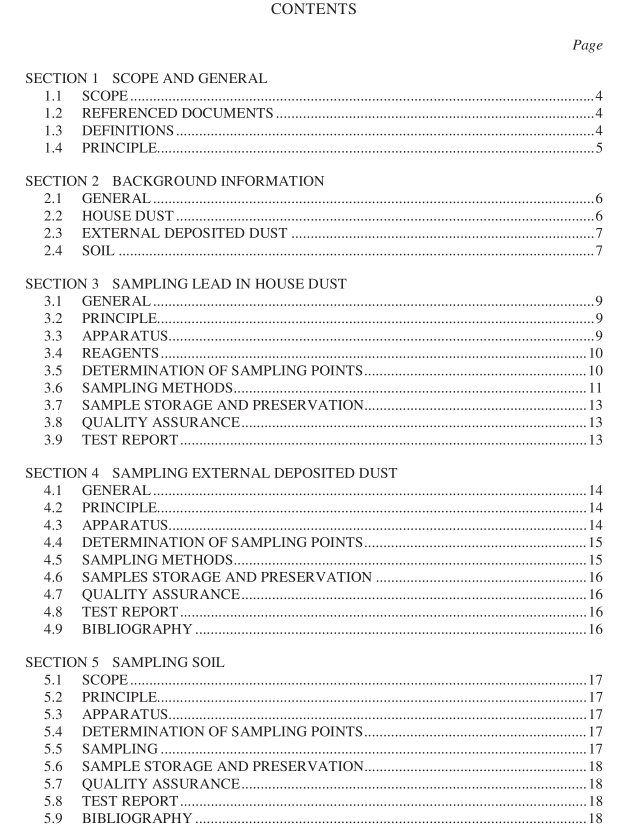AS 4874 pdf download – Guide to the investigation of potentially contaminated soil and deposited dust as a source of lead available to humans

AS 4874 pdf download – Guide to the investigation of potentially contaminated soil and deposited dust as a source of lead available to humans
3.1 GENERAL The objective of sampling house dust is to assess the risk posed by lead to occupants of the dwelling. The first step in the risk assessment process is to carry out an exposure assessment, determining the areas where exposure to house dust is likely to occur. A suitable sampling method is subsequently employed to collect dust from the surfaces in question. Hypothetical examples are given in Appendix A. There is no single method that can be recommended for the sampling of house dust from all surfaces. It is, however, possible to suggest specific sampling procedures for certain situations. This Section provides guidance on the sampling methods that are suitable for sampling dust from the types of surfaces commonly encountered in houses. 3.2 PRINCIPLE The sampling areas are selected by determining the areas to which the population has maximal exposure. When the population being studied involves children, observation of their playing habits is of use in determining the study area. Samples of dust from smooth surfaces (e.g. polished wood, plastic toys) are collected by wipe sampling and samples of dust from rough surfaces (e.g. carpets, soft toys) are collected by vacuum sampling.
3.3 APPARATUS
3.3.1 Sampling template for wipe sampling A rectangular template of dimensions appropriate to the size of the surface being sampled. A square template with a side of 30 cm has been found to be adequate in general purpose sampling, although templates of smaller or larger areas may be used for special applications. For instance, when sampling dust from window sills, it is necessary to use a sampling template with a length well in excess of its width.
3.3.2 Collection medium for wipe sampling A suitable collection medium, capable of removing lead particles from the surface should be chosen. Laboratory wipes have been found to be suitable for this purpose. Prior to use, the collection medium should be analyzed for lead content and rejected if significant lead levels are found.
NOTE: At no stage should the sampling template or collection medium be touched with bare hands or contaminated equipment. 3.3.3 Collection apparatus for vacuum sampling A suitable collection apparatus consisting of a vacuum pump, sampling nozzle and a device for trapping the collected dust. The characteristics of the equipment and the conditions required for operation should be evaluated preferably by experimentation or by reference to scientific literature, which describes an exactly equivalent system. Prior to use, the system should be demonstrated to be free of contamination. Appendix B gives details of one type of vacuum sampling system.
3.3.4 Sampling template for vacuum sampling A template of dimensions appropriate to the surface being sampled. Because of the different type of surface being sampled, the shape of templates used for vacuum sampling differs from that used for wipe sampling. A square template of side 25 cm has been found to be adequate in most situations, although triangular templates are also used for some purposes.
3.3.5 Analytical balance
Readable and accurate to ±0.00001 g.
3.3.6 Sample containers
Polypropylene plastic containers, as specified in AS 4482.1.
3.4 REAGENTS
3.4.1 Ethanol
Laboratory grade (denatured) alcohol. The alcohol should be analyzed for lead content and should not be used if it is shown to contain levels of lead that would lead to significant tamination of the dust samples.
3.4.2 Water
Deionized or glass distilled water of Grade 2 as defined in ISO 3696.
3.4.3 Ethanol (20% v/v)
To 20 parts of ethanol (3.4.1), add 80 parts of water (3.4.2) and mix thoroughly.
3.5 DETERMINATION OF SAMPLING POINTS The house should be surveyed for all possible areas of human contact. As most surveys of house dust are concerned with exposure of infants, it is important to sample from areas with which infants come into contact. The necessary information may be collected by observation of children at play, as well as, from interviews with parents, nannies, etc.









